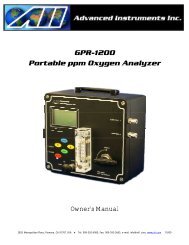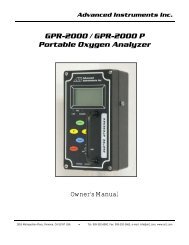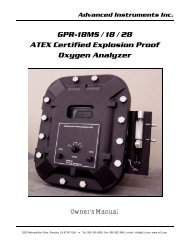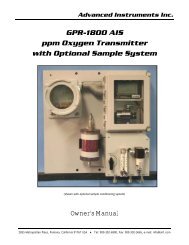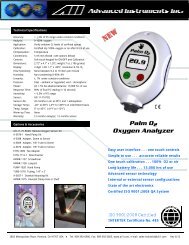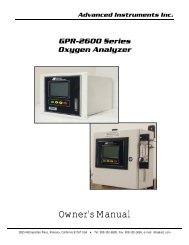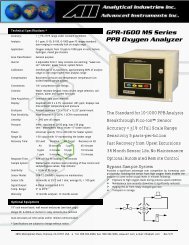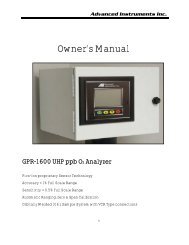Quality Assurance ProgramQuality is taken very seriously. Mandated for medical devices, industrial and divingproducts comply with the same quality standards. The quality assuranceprogram is independently certified annually by and conforms <strong>to</strong>: ISO 9001:2008, U.S. FDA: 510(k) No. K952736, Europe: Annex II of Medical Device Directive 93/42/EEC as amendedby 2007/43/EEC, Canada: ISO 13485:2003Our approach <strong>to</strong> cus<strong>to</strong>mer service is proactive one, every product returned from the field requires a formal written assessmentreport a copy of which is sent <strong>to</strong> the cus<strong>to</strong>mer. We routinely contact cus<strong>to</strong>mers <strong>to</strong> discuss and educate, and inmany cases ourselves as well.His<strong>to</strong>rically, less than 1% of the sensors shipped are returned <strong>to</strong> Analytical Industries Inc. for warranty claims, and, ofthat figure less than one-half are determined <strong>to</strong> have manufacturing defects. Assessing these returns along with internalmanufacturing yields has enabled Analytical Industries Inc. <strong>to</strong> continually improve our products and secure additionalbusiness.Serialization / Date Code<strong>Oxygen</strong> sensors have a finite life. Understanding the date code embodied in the serial number is critical <strong>to</strong> determiningthe age or manufacture date of a sensor, maximizing the benefit of the warranty period. The serial number 90734789breaks down as follows:Digit #1: 9 identifies the year of manufacture as 2009Digits #2,3: 07 identifies the month of manufacture as JulyRemaining: Sequentially issued for uniquenessTo avoid diving with aged sensors, labeling of all rebreather sensors includes a SELL BY date (4 months) and DO NOTUSE AFTER date (16 months) from the month and year of manufacture specified or July 2009 in the above example.Warranty PolicyCoverage: Under normal operating conditions, the sensors are warranted <strong>to</strong> be free of defects in materials and workmanshipfor the period specified in the current published specifications.Analytical Industries in their sole discretion shall determine the nature of the defect. If the item is determined <strong>to</strong> be eligiblefor warranty we will repair it or, at our option, replace it at no charge <strong>to</strong> you. This is the only warranty we will giveand it sets forth all our responsibilities, there are no other express or implied warranties. The warranty period beginswith the date of shipment from Analytical Industries Inc. This warranty is limited <strong>to</strong> the first cus<strong>to</strong>mer who submits aclaim for a given serial number. Under no circumstances will the warranty extend <strong>to</strong> more than one cus<strong>to</strong>mer or beyondthe warranty period.For info call 909-392-6900, fax 909-392-3665 or e-mail diveaii@aii1.com. To make a warranty claim, you must returnthe item and postage prepaid <strong>to</strong>: Analytical Industries Inc., 2855 Metropolitan Place, Pomona, Ca 91767 USAExclusions: This warranty does not cover normal wear and tear; corrosion; damage while in transit; damage resultingfrom misuse or abuse; lack of proper maintenance; unauthorized repair or modification of the analyzer; fire; flood; explosionor other failure <strong>to</strong> follow the Owner’s Manual.Limitations: Analytical Industries Inc. shall not liable for losses or damages of any kind; loss of use of the analyzer;incidental or consequential losses or damages; damages resulting from alterations, misuse, abuse, lack of proper maintenance;unauthorized repair or modification of the analyzer.2855 Metropolitan Place, Pomona, CA 91767 USA ♦ Tel: 909-392-6900, Fax: 909-392-3665, www.aii1.com, e-mail: info@aii1.com Rev 12/10
What We Have Learned . . .The effects of the <strong>to</strong>pics listed below are discussed in detail in the preceding pages and in the interest of brevity are notduplicated.Challenging Application: When it comes <strong>to</strong> the closed circuit rebreather the oxygen sensor is exposed <strong>to</strong> an environmentthat plays <strong>to</strong> more of the device’s weaknesses than its strengths. That is not <strong>to</strong> say the oxygen sensor is not suitedfor this application, but getting the most out of the oxygen sensor requires working around the limitations, understandingthe device and a little discipline in terms of handling and maintenance.Preventive Maintenance: Our investigation has yielded a surprising number of cases involving diving with old sensors,the lack of regular sensor replacement and failure <strong>to</strong> follow the rebreather manufacturer’s calibration procedure.Design: Currently there are no regulations governing rebreather manufacturers which accounts for the various designson the market.Temperature: The CO2 scrubber generates heat which keeps the temperature inside the rig around 90⁰F. The designshould locate the oxygen sensor in the coolest location possible.Liquid: The heat generated by the CO2 scrubber also produces a continual source of condensation which does notdamage the sensor itself. Again the design should position the oxygen sensors <strong>to</strong> minimize or prevent the collection ofwater on the sensing surface.Electronics: The quality of the computer systems used <strong>to</strong> control <strong>to</strong>day’s rebreathers vary from rig <strong>to</strong> rig. If the electronicsare flooded or malfunction a charge can be sent <strong>to</strong> the oxygen sensor resulting in permanent damage <strong>to</strong> the sensor,see Load. Electrical connec<strong>to</strong>rs should gold and kept watertight. However, using rubber-type caps <strong>to</strong> seal the connectionsat the back of the sensor can cause an unwanted pressure differential between the front and back of the sensor.Recommended Maintenance: Rebreather Owner’s Manuals repeatedly warn users <strong>to</strong> follow recommended maintenanceprocedures for post dive of opening and flushing the rig, proper inspection and lubrication of o-rings and seals <strong>to</strong>prevent leaks which could expose the oxygen sensors <strong>to</strong> oxygen levels of 70-100% and exposure <strong>to</strong> CO2.Shock: Even contribu<strong>to</strong>rs <strong>to</strong> the internet forums admit the rigs (and the components inside) are not accorded theproper handling, an issue for electronics as well as the oxygen sensor.2855 Metropolitan Place, Pomona, CA 91767 USA ♦ Tel: 909-392-6900, Fax: 909-392-3665, www.aii1.com, e-mail: info@aii1.com Rev 12/10



